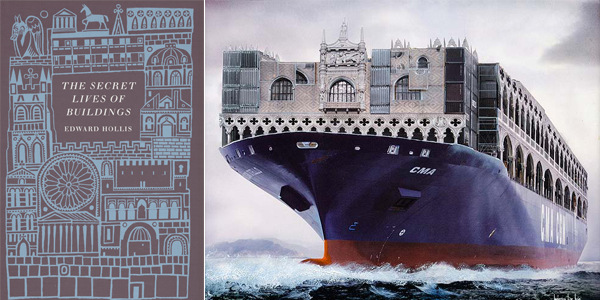Concrete, marble, steel, brick: little else made by human hands seems as stable, as immutable, as a building. Yet the life of any structure is neither fixed nor timeless. Outliving their original contexts and purposes, buildings are forced to adapt to each succeeding age. To survive, they must become shape-shifters.
Edward Hollis recounts more than a dozen stories of such metamorphosis, highlighting the way in which even the most familiar structures all change over time into "something rich and strange." The Parthenon, that epitome of a ruined temple, was for centuries a working church and then a mosque; the cathedral of Notre Dame was "restored" to a design that none of its original makers would have recognized. Remains of the Berlin Wall, meanwhile, which was once gleefully smashed and bulldozed, are now treated as precious relics.
Buy the US edition of the Secret Lives of Buildings here
'The Secret Lives of Buildings' & the Oft Egotistical & Obsessive People Behind Them'
Richard Elliot at www.popmatters.com 11.3.11
''no matter how familiar these works may be, he turns the story of each structure and its subsequent transformations into an informative parable about the inevitable metamorphoses of the built environment.''
20.5.10 Martin Filler in the New York Review of Books
'Hollis is an evocative storyteller when he's weaving different strands of history...'
17.01.10 Glen Perkins reviews The Secret Lives of Buildings for News Observer.com
....what it is, in fact, is an unusual sort of speculative history, almost a work of experimental fiction. The buildings, which are its nominal subjects, are only MacGuffins on which Hollis hangs a series of short stories on the themes of love, loss and time.
Ian Volner reviews The Secret Lives of Buildings in Time Out New York 12th January 2010
....he brings together an iconoclastic attitude and a lively writing style to create a kind of counter-history of architecture
Kirk Savage reviews the Secret Lives of Buildings in the Washington Post 10.01.10
Delightful ... A beautifully wrought book... Here are wondrous stories writ in stone, and Edward Hollis has written about them very well indeed.
Jonathan Glancey, The Guardian, 12th September 2009
For Hollis, ruination is merely one stage in a building's passage from idea through reality to enduringly contested myth neither to be celebrated nor deplored. But there is something Sebaldian about The Secret Lives of Buildings: a digressive pleasure in the sheer strangeness of architecture and the mortal intrigues by which it was wrought.
Brian Dillon, Independent on Saturday 23rd October 2009
[An] accessible and ambitious exploration of the nature and meanings of architecture, Hollis has the gift of making these buildings seem real and alive without recourse to illustrations. Much of his prose has an old-fashioned cadence, sounding echoes, in places, of Ruskin's The Stones of Venice.
The Sunday Times (UK)
Quite unlike any other recent book on architecture and a worthy nominee for the Guardian First Book Award - Building Design (UK)
This beautiful book tells the story of 13 widely varied but uniquely significant structures in a totally captivating and novel way.
Waterstone's Books Quarterly
Beautifully written and produced, The Secret Lives of Buildings gives the reader word-pictures of the dreams and conceptions which gave rise to the ancient buildings such as the Parthenon, Notre Dame and the Alhambra.
The Catholic Herald
Engaging and erudite... Hollis is magical on the layers of myth and history in the classical world.
Financial Times 5th September 2009
...if the first chapter of my own dusty history of architecture textbook had been entitled The Parthenon, Athens: In Which a Virgin is Ruined, I imagine I'd have slept through a lot less of my lectures.
The Scotsman 12th September 2009
Tremendous... It's unusual for a nonfiction book to match a neat conceit with elegant execution, but Hollis has achieved it. The stories are actually stories, not mere scrolls of fact. It helps that he has a beautifully wry tone... Hollis experiments with structure, chronology, leitmotifs and repetitions, and makes his book a rare thing: nonfiction you can reread.
Scotland on Sunday 13th September 2009
Hollis moves gracefully through both buildings and historical periods with an impressive command of detail and a sensitivity to the people involved. A strong, satisfying exploration of the history, beauty, and wonder of Western architecture.
Kirkus Reviews (US)
Edward Hollis rewrites architectural history in this beautiful and unsettling study of how the masterpieces of Western architecture have changed over time. Temples become mosques; monuments become ruins; deserts become cities, and deserts again. After reading this book, no building will seem quite the same.
Christopher Woodward, author of In Ruins: A Journey Through History, Art, and Literature
